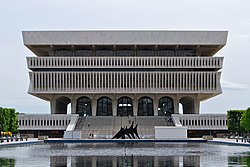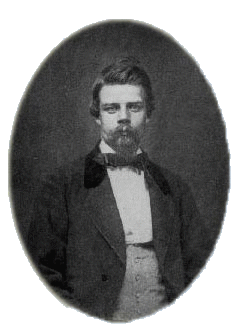
William Bell Wait (1839–1916) was a teacher in the New York Institute for the Education of the Blind who invented New York Point, a system of writing for the blind that was adopted widely in the United States before the braille system was universally adopted there. Wait also applied the New York Point principles to adapt them for use in over 20 languages, created a form of New York Point to notate music, and invented a number of devices to better type and print embossed material for the visually impaired.
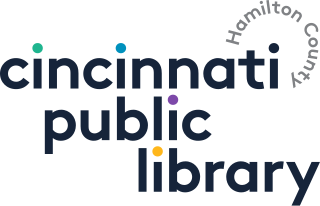
Cincinnati and Hamilton County Public Library (CHPL) is a public library system in the United States. In addition to its main library location in downtown Cincinnati, Ohio, CHPL operates 40 regional and branch locations throughout Hamilton County.

The California State Library is the state library of the State of California, founded in 1850 by the California State Legislature. The Library collects, preserves, generates and disseminates a wide array of information. Today, it is the central reference and research library for state government and the Legislature. The California State Library advises, consults with and provides technical assistance to California's public libraries. It directs state and federal funds to support local public libraries and statewide library programs, including Institute of Museum and Library Services (IMLS) grants. The California State Library's mission is to serve as "...the state’s information hub, preserving California’s cultural heritage and connecting people, libraries and government to the resources and tools they need to succeed and to build a strong California." With the exception of the Sutro Library in the J. Paul Leonard Library at San Francisco State University, the other three branches are located in Sacramento, California, at 914 Capitol Mall, 900 N Street and at the State Capitol.

The Alaska State Library and Historical Collections and Talking Book Center are located on the second floor of the Andrew P. Kashevaroff Building in Juneau, Alaska.

The State Library of Kansas is a department within the state government of Kansas, with locations in Topeka and Emporia. Ray Walling was appointed acting State Librarian in June of 2022.
The State Library of Oregon in Salem, is the library for the U.S. state of Oregon. The mission of the State Library of Oregon is to provide leadership and resources to continue growing vibrant library services for Oregonians with print disabilities, the Legislature and state government, and all Oregonians through local libraries.
Kentucky Department for Libraries and Archives is a collection of library and information resources. KDLA's mission is to serve "Kentucky's need to know" through its services "assuring equitable access" to information and services. Many of the materials available from KDLA are public domain.
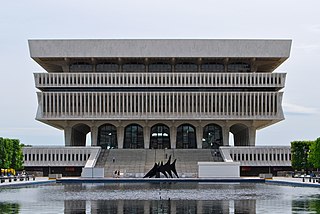
The New York State Museum is a research-backed institution in Albany, New York, United States. It is located on Madison Avenue, attached to the south side of the Empire State Plaza, facing onto the plaza and towards the New York State Capitol. The museum houses art, artifacts, and ecofacts that reflect New York’s cultural, natural, and geological development. Operated by the New York State Education Department's Office of Cultural Education, it is the oldest and largest state museum in the US. Formerly located in the State Education Building, the museum now occupies the first four floors of the Cultural Education Center, a ten-story, 1,500,000-square-foot (140,000 m2) building that also houses the New York State Archives and New York State Library.
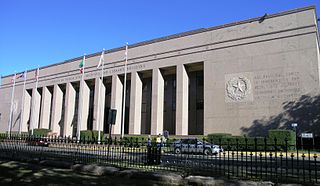
The Texas State Library and Archives Commission (TSLAC) refers to the state government agency in the state of Texas that supports the reading, learning, and historical preservation needs of Texas and its people. The agency is charged with preserving the archival record of Texas, supporting research, and making primary resources available to the public; assisting public, academic, and school libraries across the state in meeting the needs of their communities and students; helping public agencies maintain their public records; and supporting the reading needs of thousands of Texans with disabilities preventing them from reading a standard book.
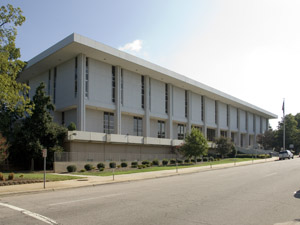
The State Library of North Carolina is an institution which serves North Carolina libraries, state government employees, genealogists, and the citizens of North Carolina. The library is the main depository for North Carolina state publications and serves the needs of North Carolina government agencies and state government employees by providing access to information resources that are vital to public decision-making and economic development.

The Connecticut State Library is the state library for the U.S. state of Connecticut and is also an executive branch agency of the state. It is located in Hartford, Connecticut directly across the street from the Connecticut State Capitol. The State Library provides a variety of library, information, archival, public records, museum, and administrative services to the citizens of Connecticut, as well as the employees and officials of all three branches of state government. Students, researchers, public libraries and town governments throughout the state are also served by the State Library. In addition, the State Library directs a program of statewide library development and administers the Library Services Technology Act state grant. "The mission of the Connecticut State Library is to preserve and make accessible Connecticut's history and heritage and to advance the development of library services statewide."
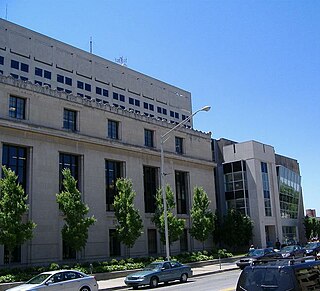
The Indiana State Library and Historical Bureau is a public library building, located in Indianapolis, Indiana. It is the largest public library in the state of Indiana, housing over 60,000 manuscripts. Established in 1934, the library has gathered a large collection of books on a vast variety of topics.

The Tennessee State Library and Archives (TSLA), established in 1854, currently operates as a unit of the Tennessee Department of State. According to the Tennessee Blue Book, the Library and Archives "collects and preserves books and records of historical, documentary and reference value, and encourages and promotes library development throughout the state." This mandate can be found in Tennessee Code Annotated, Title 10, Chapters 1-8.

The slate and stylus are tools used by blind people to write text that they can read without assistance. Invented by Charles Barbier as the tool for writing letters that could be read by touch, the slate and stylus allow for a quick, easy, convenient and constant method of making embossed printing for Braille character encoding. Prior methods of making raised printing for the blind required a movable type printing press.

The Nebraska Library Commission is a Nebraska state government agency. Located in Lincoln, the Library Commission provides reference, resources, training, and consulting for all types of library in the state. The various collections housed at the Library Commission are used to serve librarians, state employees, seekers of government information, and visually handicapped Nebraskans. The Library Commission is a clearinghouse for state government publications and makes many documents accessible online.
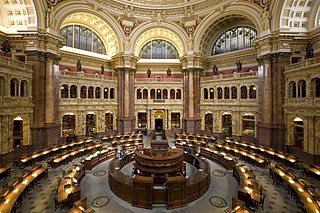
The Library of Congress (LOC) is a research library in Washington, D.C., that serves as the library and research service of the U.S. Congress and the de facto national library of the United States. Founded in 1800, the library is the United States's oldest federal cultural institution. The library is housed in three elaborate buildings on Capitol Hill. It also maintains a conservation center in Culpeper, Virginia. The library's functions are overseen by the Librarian of Congress, and its buildings are maintained by the Architect of the Capitol. The Library of Congress is one of the largest libraries in the world. Its collections contain approximately 173 million items, and it has more than 3,000 employees. Its collections are "universal, not limited by subject, format, or national boundary, and include research materials from all parts of the world and in more than 470 languages".

The Washington Talking Book & Braille Library (WTBBL) is a specialized public library in Seattle, Washington, US, serving individuals in the State of Washington who are unable to read standard print material. It is administered by the Washington State Library. The library's collection includes large print books, Braille books, audio cassette books, and digital cartridge books. It also provides a recording service for audiobooks, a Braille service, disability-focused reference service, and a variety of youth services.

The American Printing House for the Blind (APH) is an American non-for-profit corporation in Louisville, Kentucky, promoting independent living for people who are blind and visually impaired. For over 150 years APH has created unique products and services to support all aspects of daily life without sight.
The Washington State Library is a government agency that operates public libraries in Washington state's prisons and mental hospitals, and maintains collections related to the state government. Based in Tumwater, it is a service of the Washington Secretary of State and was founded in 1853 as the Washington Territorial Library. The library has a collection of 2.25 million physical items and other online resources available to residents of the state.
Minnie Crabb (1885–1974) was the inventor of the Crabb-Hulme Braille printing press, the first Australian braille printing press. Her work was instrumental in braille accessibility and production in Australia.

